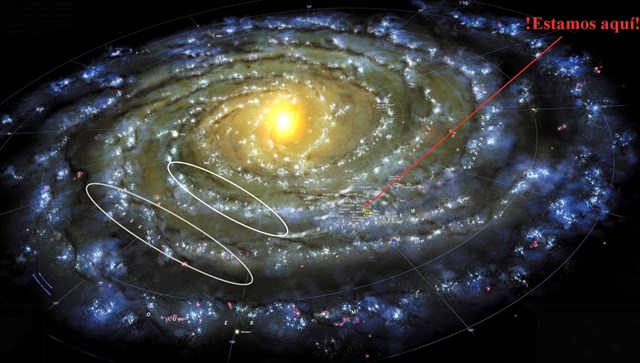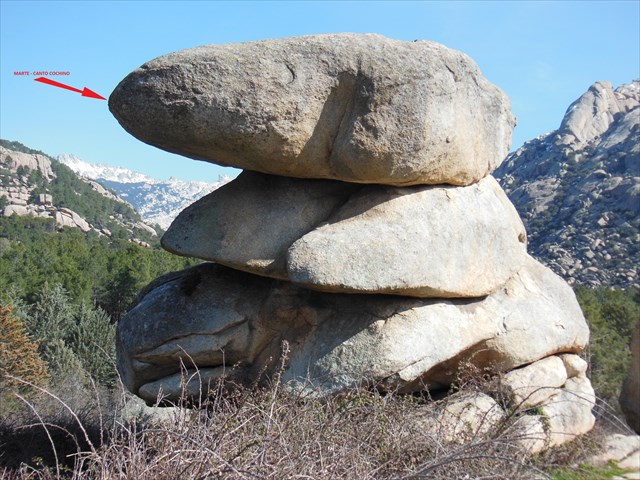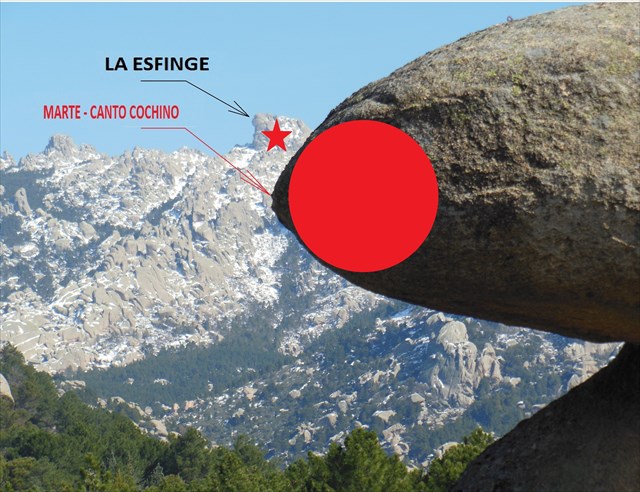CANTOCOCHINO - MOVIMIENTO RETRÓGRADO EarthCache
CANTOCOCHINO - MOVIMIENTO RETRÓGRADO
-
Difficulty:
-

-
Terrain:
-

Size:  (other)
(other)
Please note Use of geocaching.com services is subject to the terms and conditions
in our disclaimer.
Este caché os mostrará con un breve recorrido, el movimiento retrógrado de los planetas.
This cache will show with a short tour, the RETROGRADE MOTION of the planets in the sky.
SPANISH VERSION
Se sospecha que desde los tiempos de los mayas ya se conocía el movimiento aparentemente errático de los planetas en el cielo, vistos desde la Tierra, que no era otra cosa que la composición de los dos movimientos del planeta moviéndose en su órbita y la Tierra recorriendo la suya.
Este movimiento errático es mucho más característico en los planetas exteriores (Marte, Júpiter, etc), vistos desde la Tierra. Si dibujamos un mapa del cielo estrellado nocturno y anotamos las posiciones de Marte noche tras noche, veremos que sigue una lenta trayectoria hacia el Este (recorriendo la ECLÍPTICA SOLAR), llega un momento en que se detiene aparentemente, inicia un MOVIMIENTO RETRÓGRADO hacia atrás, se detiene de nuevo y sigue su camino hacia adelante. Esto ocurre así, visto desde la Tierra, porque el tiempo que tarda la Tierra en recorrer su órbita es de 365 días, mientras que Marte recorre la suya en 687 días. La Tierra adelanta a Marte en una trayectoria interior, y por tanto Marte se queda retrasado visto contra el fondo de estrellas de referencia.
El siguiente gráfico os mostrará de forma sencilla la explicación anterior.

La Tierra en los puntos 1, 2, 3 adelanta a Marte por el interior. A partir del punto 3, Marte se queda retrasado contra el fondo de estrellas y a partir del punto 5, Marte retoma su carrera hacia adelante.
CURIOSIDAD: ¿Sabes que todos los planetas orbitan alrededor del Sol en un mismo plano? En consecuencia, visto el Sol desde la Tierra, pasa todos los días por una misma línea imaginaria del cielo llamada ECLÍPTICA SOLAR, y por esa misma línea se ven pasar por la noche, aunque muchísimo más despacio, todos los planetas exteriores (Marte, Júpiter, Saturno, etc)
En realidad la eclíptica está algo más baja en el cielo nocturno en verano y más alta en invierno debido a la inclinación del eje de la Tierra, respecto del plano orbital, en el giro alrededor del eje de los Polos. Por el día, al revés, veremos el Sol más alto en verano que en invierno.
La ECLÍPTICA SOLAR tiene como fondo fijo de estrellas en el cielo, las 12 Constelaciones del Zodíaco, recorriendo cada una en un mes aproximadamente, y por ello decimos, por ejemplo, que nuestro signo zodiacal es Leo, porque el Sol, en el momento de nuestro nacimiento entre el 23 de julio y el 22 de agosto, estaba pasando por delante de la constelación de Leo, visto desde la Tierra.
Por supuesto que en ese mes, durante la noche no veremos a Leo. La Tierra habrá girado media vuelta y veremos la constelación Zodiacal que está en el lado opuesto, es decir, Acuario. Leo lo veremos en el Cielo nocturno, 6 meses después, en febrero, cuando la Tierra esté en el punto opuesto de su órbita.
PTOLOMEO
Esto era difícil de explicar según la teoría geocéntrica de Ptolomeo según la cual todos los objetos celestes giran en torno a la Tierra. Tuvieron que inventarse el EPICICLO para explicarlo. El epiciclo daba una explicación a la retrogradación de los planetas. Quedaba por explicar suficientemente, su aumento de brillo mientras retrogradan y la distinta duración de las revoluciones siderales.
La teoría geocéntrica daba al Hombre el papel elegido por Dios de ser el centro de la creación, y en verdad, aparentemente mirando al cielo, parecía que todo (Luna, Sol, y planetas), giraba en torno a la Tierra.
COPÉRNICO, KEPLER Y GALILEO
Fue Copérnico quien desarrolló la teoría heliocéntrica, ya adelantada por Aristarco de Samos, según la cual todos los objetos giran en torno al Sol. Su teoría fue una revolución considerada herética pues suponía, que ya el Hombre no era el centro de la creación, otorgándole un papel mucho más secundario.
Kepler y Galileo, continuando el modelo de Copérnico terminaron de explicar el modelo heliocéntrico, luchando “heréticamente” contra la concepción antropocéntrica del Universo.
La célebre frase “Eppur si muove” es la polémica frase que, según las crónicas, masculló entre dientes Galileo Galilei, después de abjurar de la visión geocéntrica del mundo ante el tribunal de la Santa Inquisición. Galileo demostró con su telescopio que podía verse claramente que no todo giraba en torno a la Tierra: allí estaban las 4 Lunas de Júpiter (Calixto, Ganímedes, Ío y Europa) girando claramente en torno a él. Por tanto, el hombre no era el centro de la Creación. Ahora sabemos que vivimos en un planeta pequeño, en un sistema Solar de reducidas dimensiones, con una estrella, el Sol, de mediano tamaño, ocupando un humilde espacio de uno de los brazos espirales, el BRAZO DE ORIÓN, muy alejado del centro de nuestra Galaxia, la Vía Láctea, en el infinito Universo.

Para saber más…
Lectura recomendada, librito muy sencillo y divulgativo:
LA GUÍA DEL CIELO. Editorial Cuadernos Procivel (5,50€ la del 2014)
Aplicación para móviles: GOOGLE SKY MAP. Fabuloso software!
http://apod.nasa.gov/apod/ap100613.html
http://mayananswer.over-blog.com/article-venus-y-kukulkan-61718667.html
http://astro.unl.edu/naap/ssm/animations/configurationsSimulator.html
http://astro.unl.edu/naap/ssm/animations/ptolemaic.html
http://www.webdianoia.com/moderna/copernico/copernico_fil3.htm
EL CACHÉ.
El punto de coordenadas inicial os llevará a un enebro situado en el aparcamiento de Canto Cochino. Desde ahí iniciamos un breve recorrido a través de los puntos R1, R2, R3, R4, R5 y R6 Suponiendo que nosotros mismos somos el Planeta Tierra girando alrededor del Sol que estará representado por el árbol que queda en medio del recorrido.
Marte, el PLANETA ROJO, está representado por el extremo Oeste de la roca Canto Cochino (ver flecha y CÍRCULO ROJOS en la foto).

El fondo fijo de estrellas está representado por los riscos del Circo de la Pedriza posterior (Caballito de Ajedrez, La Esfinge, las Torres, etc).
En concreto, nos fijaremos en La Esfinge (ESTRELLA ROJA en la foto), para relacionarla con el movimiento aparente de Marte-Canto Cochino, cuando nos desplacemos en nuestro recorrido desde R1 hasta R6

Veremos que en nuestro recorrido de R1 a R6, Marte-Canto Cochino (CÍRCULO ROJO) se desplaza hacia la izquierda, llega un momento en que se para, asciende un poco, y se desplaza hacia la derecha en movimiento retrógrado, tomando como referencia La Estrella-Esfinge del fondo (ESTRELLA ROJA).
Fijaos también cuando vayáis en coche por una autopista, (si vais de copiloto, no conduciendo), en el movimiento retrógrado de las farolas contra el fondo del horizonte.
PARA REGISTRAR EL CACHÉ hay que contestar unas breves preguntas enviando un email a la dirección suministrada en mi perfil de geocaching (ppot) y ESPERAR A MI APROBACION POR EMAIL.
Tras la aprobación podrás registrar la visita y se agradecerá que subas una foto tuya con el GPS al registro, teniendo al mismo tiempo por detrás alineado Canto Cochino con La Esfinge
LOGGING TASKS:
1.- ¿En qué punto R1 a R6 se detiene el movimiento de Marte-Canto Cochino hacia la izquierda?
2.- Indica el nombre de una estrella real del fondo estrellado que pudiera ser representada por la Estrella-Esfinge, y en qué constelación está.
Por favor, recordad hacer click en la casilla que dice "Quiero enviar mi dirección de correo electrónico con este mensaje" cuando me enviéis el email para que os pueda contestar a vuestra solución.
ENGLISH VERSION
It is suspected that the old Mayans already knew the apparently erratic movement of the planets in the sky, as they are seen from Earth, that it is simply the composition of two movements: the planet moving in its orbit, and the Earth traveling in its own orbit.
This erratic movement is much more characteristic of the outer planets (Mars, Jupiter, etc.), as seen from Earth. If we draw a map of the starry sky at night, and note the positions of Mars, night after night, we see that it moves a slow path to the East (running the Solar ECLIPTIC), then comes a time when seemingly stops, starts a RETROGRADE MOVEMENT back; stops again, and continues its way forward. This is so, as seen from Earth, because the time it takes the Earth to travel its orbit is 365 days, while Mars spends 687 days giving a round around the Sun. Earth overtakes Mars on an inside path, and thus, a delayed Mars is seen against the background of reference stars.
The first chart above and the English caption of the picture uploaded below, will show you, in a simple way, the above explanation.
AMAZING FACT:
Did you know that all the planets orbit the Sun in the same plane? Consequently, the Sun seen from Earth, happens every day by the same imaginary line called ECLIPTIC SOLAR sky, and by the same line are going through the night, although much more slowly, all the outer planets (Mars, Jupiter , Saturn, etc.)
Actually the ecliptic is somewhat lower in the evening sky in summer and higher in winter due to the tilt of Earth's axis, with respect to the orbital plane, the rotation about the axis of the poles. By day, backwards, we see the sun higher in summer than in winter.
The ECLIPTIC (the Sun's Annual Path on the Celestial Sphere) has as the fixed background of stars in the sky, the 12 constellations of the Zodiac, visiting each in about a month, and so we say, for example, that our star sign is Leo, because the Sun, at the time of our birth between July 23 and August 22, was passing in front of the Leo constellation, as seen from Earth.
Of course, in that month, at night we will not see Leo. The Earth will have rotated around itself and so we will see the Zodiacal constellation that is on the opposite side, ie Aquarius. Leo will be seen in the night sky, six months later, in February, when the Earth is at the opposite point of its orbit.
PTOLEMY
This was difficult to explain according to Ptolemy's geocentric theory according to which all celestial objects revolve around the Earth. They had to invent the EPICYCLE to explain it. The epicycle gave an explanation for the retrograde motion of the planets. It did not explain enough its increased brightness while they retrograde and the different duration of the sidereal revolutions.
The geocentric theory assigned the Human Being the role chosen by God to be the center of the Creation, and to tell the truth, apparently looking at the sky, it seemed that everything (Moon, Sun, and planets), revolve around the Earth.
COPERNICUS KEPLER & GALILEO
It was Copernicus who developed the heliocentric theory. It was originally advanced by Aristarchus of Samos, according to which all objects revolve around the Sun. His theory was considered a heretical revolution as it implies that men are not the center of Creation, giving them a much more secondary role.
Kepler and Galileo, ultimate the unfinished Copernicus model to explain the heliocentric theory, fighting heretically against the anthropocentric conception of the Universe.
The famous phrase "Eppur si muove" is the controversial phrase apparently muttered by Galileo Galilei, after abjuring of the geocentric conception of the world at the Inquisition Tribune. Galileo proved with his telescope he could clearly see that not everything revolved around the Earth: There were the four moons of Jupiter (Callisto, Ganymede, Io and Europe) clearly rotating around it. Therefore, the man was not the center of the Creation.
Now we know that we live on a small planet in a solar system small in size, with a star, the Sun, of medium size, occupying a humble space of one of the spiral arms, the ORION ARM, far from the center of our Galaxy, the Milky Way, in the infinite Universe.
TO KNOW MORE:
Mobile Application: GOOGLE SKY MAP. Outstanding software!
http://apod.nasa.gov/apod/ap100613.html
THE CACHE
The point of initial coordinates will take you to a juniper tree located in the parking lot of CANTOCOCHINO. From there, a short tour begins through points R1, R2, R3, R4, R5 and R6, simulating the Earth in its orbit round the Sun. Assuming that ourselves are the planet Earth revolving around the Sun which is represented by the tree that is in the center of the route (point S1).
Mars, the RED PLANET, is represented by the Western edge of Cantocochino Rock (see RED ARROW & CIRCLE in the picture).
The fixed background of stars is represented by the cliffs of the Pedriza Circus in the back (Chess Horse, The Sphinx, the 4 Towers, etc.). Specifically, we look at the Sphinx, to relate the apparent motion of Mars-Cantocochino, when we move on our journey from R1 to R6
We will see that in our route from R1 to R6, Mars-Cantocochino (RED CIRCLE in the picture) moves to the left, then it stops, rises a little, and moves to the right in retrograde motion, while we look as a reference to the Star-Sphinx background (RED STAR in the picture).
Look also when you go by car on a highway, (if you go for passenger, not driving) in the retrograde motion of the lamps against the background of the horizon.
To LOG the cache you should answer a few questions by email to the email address provided in my geocaching profile (ppot) and WAIT FOR MY APPROVAL BY RETURN EMAIL. After getting my approval you can log the visit. Uploading a picture of yourself with your GPS while having Canto Cochino aligned with the Sphinx in the picture background, will be highly appreciated:
LOGGING TASKS:
1. - What point R1 to R6 does Mars-Canto Cochino stop the motion to the left at?
2. - Indicate the name of a real star in the starry background that could be represented by the Star-Sphinx, and which constellation belongs to.
Answers in English are accepted.
Please remember to click in the box "I want to send my email address along with this message." so I can respond when I receive your solution by email.
Os deseo mucha suerte en vuestras observaciones del cielo nocturno.
ppot

Additional Hints
(No hints available.)
Treasures
You'll collect a digital Treasure from one of these collections when you find and log this geocache:

Loading Treasures